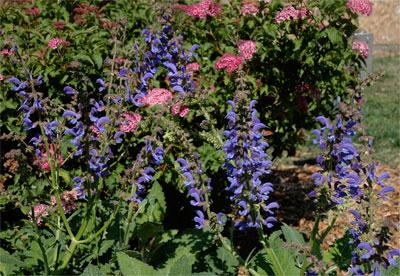
Plant of the Month: Salvia transylcanica
Blue Cloud
Salvia Transylvanica ‘Blue Cloud’
At a glance
Scientific name: Salvia transylvanica
Hardiness zones: 5a – 8b
Hardiness degree: -20 F
Blooming season: late spring, summer, late summer
Plant habit: upright
Characteristics: attracts bees, butterflies, hummingbirds, drought-tolerant, heat-tolerant, low-maintenance
Spacing: 24-32"
Height: 30-36"
Width: 24-30"
Exposure: sun
Uses: background, garden bed, landscape, perennial garden
Here is one salvia I guarantee that you’ll remember the Latin name for! Salvia transylvanica ‘Blue Cloud’ or Transylvanian sage. No, I’m not joking! This salvia is actually native to Romania. I’ve grown it for over 10 years, and I find it indispensable for perennial borders.
Why haven’t you heard of it? I’m not really sure, but I have a theory. There are many blue salvias to choose from, and you may be familiar with some like Salvia x superba ‘Blue Queen’ or ‘May Night.’ They were bred to be compact and look incredible in a one-gallon pot. ‘Blue Cloud’ salvia, on the other hand, gets a little bigger and just doesn’t look as good in a pot that small. But it looks awesome in the landscape! I like it combined with Artemisia ‘Powis Castle’ or other silver-foliaged plants, and mixed with the orange and yellow flowers of daylilies.
This hardy perennial forms tight rosettes of flat foliage though the winter. In early summer it produces numerous spikes of deep-blue lobster-claw-like flowers that get to three feet tall. If you cut back the old stems, it will re-flower. I recommend placing it in the front of the border so the foliage will not get lost among taller plants.
Salvia transylvanica grows best in full sun in well-drained soil. It is not choosy about soil pH, and it is very drought tolerant. After the first killing frost, cut plants back to the ground and new foliage will quickly appear and stay evergreen throughout winter.
I recommend looking for this plant in your garden center this spring. If they don’t carry it, ask them to order it for you, or do a Google search and purchase it from an online company. You can purchase it as potted plants or as seed.
